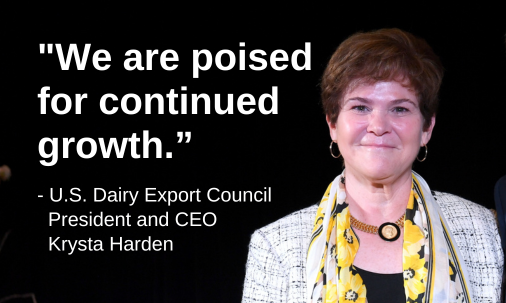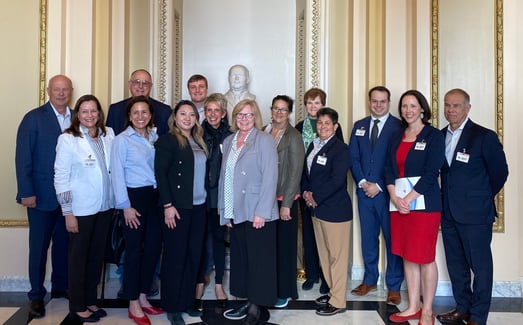-
What's next for rising U.S. dairy exports?
By USDEC Staff April 4, 2023- Tweet
The consensus at USDEC's Spring Board of Directors meeting was that U.S. dairy exports would continue to grow in 2023 but may not match last year's lofty 5% increase.

After three straight years of breaking records, what's next for U.S. dairy exports?
That was the overarching question at the U.S. Dairy Export Council's Spring Board of Directors Meeting held March 27-29 in Washington, D.C.
USDEC President and CEO Krysta Harden captured the guarded optimism of the three-day meeting when she told attendees, "The long-term outlook for U.S. dairy exports is extremely bright. We are poised for continued growth."
Looking ahead to the global dairy market, past performance does not guarantee future results.
U.S. supplier consistency a key to success
A growing reputation for reliability and an ample supply provided by U.S. farmers and dairy processors has helped get more milk and dairy products shipped across U.S. borders than ever before. That fact delivers hope because exports help everyone in the U.S. dairy industry and the local economies where they live.
USDEC member companies have demonstrated that exports are an integral part of their businesses, not an afterthought, overcoming COVID, a supply-chain crisis, a tilted trade policy playing field and other challenges.
"The message to our dairy customers around the world is that we will consistently meet their needs now and as their demand grows in the future," said Harden in her address.
The long and steady growth of U.S. dairy exports
The trend toward more reliability and consistency is part of a long and steady international expansion of U.S. dairy, facilitated by USDEC, which was founded in 1985 by Dairy Management Inc. with dairy checkoff program funding. DMI remains USDEC's parent organization, getting most of its budget through the dairy checkoff.

In 2022, the United States set new records for dairy export volume (2.4 million metric tons, milk solids equivalent), value ($9.6 billion) and percentage of U.S. milk production exported (18%)
In a Q&A session with USDEC members, Harden was asked if 2023 would yield another record for the percentage of U.S. milk production exported. Citing headwinds, including the "wild card" of China, Harden remained cautiously upbeat, saying, "We might not grow as much as we have been growing, but we're hoping for a little bit more."
Economists at the meeting (read below) expressed a similar outlook that growth will continue but slower.
Where would U.S. dairy be without exports?
What is clear, said Harden, is that the U.S. dairy industry needs exports and sees it as an engine for growth. "Where would we be without that 18% going to exports," Harden asked rhetorically. "That would be a pretty big drain."
In 2022, the U.S. set new records for dairy export volume and value. "These are numbers I think just about any industry would be happy to have," considering geopolitical and economic challenges in the world, USDEC CEO Krysta Harden said today at the USDEC membership meeting. pic.twitter.com/IX1Y8OSJ0j
— U.S. Dairy Exporter (@USDairyExporter) March 28, 2023The United States' growth as a committed, consistent global dairy supplier delivering a portfolio of products suiting the needs of overseas buyers has driven U.S. dairy exports for decades, with USDEC there every step of the way.
In 2022 alone, USDEC staff traveled a combined 2.6 million air miles—the equivalent of five round-trip visits to the moon—for a broad array of activities aimed at building demand for U.S. exports and facilitating trade flows.
A high-level lineup of speakers delivers insights
While Harden's remarks set the tone for the meeting, USDEC secured a list of high-level government officials and business executives to offer their expert opinions on dairy trade challenges and opportunities, from prospects for free trade agreements to geographic indications to dairy alternatives.

USDEC President and CEO Krysta Harden, left, with Rep. Dusty Johnson (R-SD) after a session addressing Congress' outlook on agricultural issues.
The lineup included:
- U.S. Representative Dusty Johnson's assessment of the political landscape for agricultural issues and the need for improved market access for exports.
- Scott Gottlieb, former Food and Drug Administration commissioner, on the FDA's role in facilitating agricultural trade and his experiences leading the agency.
- Ambassador Doug McKalip, chief agricultural negotiator at the Office of the United States Trade Representative (USTR), and Alexis Taylor, undersecretary for trade and foreign agricultural affairs at USDA, about the 2023 agricultural trade landscape.
- A discussion about strengthening global connections with Michelangelo Margherita, head of trade section of the European Commission; Lloyd Day, deputy director general of the Inter-American Institute for Cooperation on Agriculture, and Ambassador Esteban Moctezuma, Ambassador Extraordinary and Plenipotentiary of Mexico to the United States of America.
- Tom Halverson, CEO of CoBank, providing a primer on globalization and deglobalization and ag's role in feeding the world.
- James Caffyn, partner, Lever VC, on the evolution of plant-based and fermentation-derived dairy alternatives and how they relate to dairy.
Challenges: Uncertain China demand, improved EU dairy supply
One session featured USDEC's Economics team expressing differing opinions on their expectations for U.S. dairy export performance in 2023. One area that generated consensus was that U.S. dairy export volume growth in 2023 is unlikely to match 2022's lofty 5% increase (milk solids equivalent or MSE).
U.S. dairy exporters face a series of challenges in 2023, including a weaker price environment, improved dairy supply out of the EU, uncertain Chinese demand and major questions about the global economy. That being said, William Loux, USDEC director, Economic Research and Analysis, expects solid demand for U.S. dairy ingredients in key growth markets, like nonfat dry milk/skim milk powder in Mexico and high-value whey in Japan, will still fuel a gain of more than 1.5% MSE.
In real-time audience polling, 58% of attendees sided with Loux, expecting U.S. MSE export growth to top 1.5% in 2023.
That's the short term. Looking years into the future, the market dynamics that have helped carry U.S. dairy exports to this point remain favorable. A rising global population, growing middle class and the need for sustainable, affordable nutrition are expected to drive world dairy consumption, benefitting U.S. exports.
Fly-in conveys dairy priorities to Washington policymakers
Nine members of the USDEC Operating Committee conducted a Capitol Hill "fly-in" following the membership meeting for a day-and-a-half of meetings with congressional representatives and administration officials.
Participants included USDEC Chairman Larry Hancock; Vice Chair Alex Peterson; Pennsylvania dairy farmer Marilyn Hershey; Patti Smith, DairyAmerica; Jing Hagert, Milk Specialties Global; Greg Rodriguez, MCT Dairies; Sheryl Meshke, AMPI, Jeff Schwager, Sartori; and Alison Rosenblum, Tillamook County Creamery Association.

USDEC staff and members of USDEC's Operating Committee met with Rep. Michelle Fischbach (center) during their visit to Capitol Hill to talk about dairy trade priorities.

Fly-in participants with FAS and AMS staff, including FAS Administrator Daniel Whitley (center front, left of Krysta Harden).
Accompanied by Harden, COO Martha Scott Poindexter and the USDEC Trade Policy team (Jaime Castaneda, Shawna Morris and Tony Rice), the group emphasized the need for increased funding for key FAS market development programs like the Market Access Program and for a larger U.S. government role in protecting common food names.
The group also touched on the significant role exports play in the health of the entire U.S. dairy supply chain, the U.S. economy and jobs.
10 Most Recent Posts
Most Popular Posts in Past Year
Index of Posts by Topic
- #GotDairyJobs (4)
- About USDEC (66)
- Africa (6)
- Australia (4)
- Blog (8)
- Brazil (4)
- Canada (20)
- Central America (1)
- Cheese (58)
- Chile (1)
- China (54)
- Common food names (7)
- Company News (20)
- Consistent Supply (1)
- Crisis Management (3)
- Cuba (2)
- Dairy (6)
- Dairy checkoff (9)
- Dairy Ingredients (5)
- Dairy Management Inc. (2)
- Dairy Resources (1)
- Dairy Supply Chain (1)
- Dairy Trends (5)
- Documentation (3)
- EU (24)
- Experts on Dairy Exports (4)
- Exporter of the Year (2)
- Exports (24)
- Farmer leaders (1)
- Farming (38)
- Food Aid (8)
- Food Safety (8)
- Foodservice (3)
- Free trade agreements (34)
- Future trends (1)
- Geographical Indications (GIs) (10)
- Global Marketing (86)
- Global Shipping Crisis (1)
- Got Jobs? (9)
- Indonesia (1)
- Innovation (17)
- Japan (17)
- Krysta Harden (1)
- Market Access (25)
- Market Conditions (268)
- Member Services (17)
- Mexico (41)
- Middle East (9)
- Middle East & North Africa (3)
- Middle East/North Africa (9)
- Milk (4)
- Milk Protein Concentrate (MPC) (2)
- New Zealand (11)
- Next5% (20)
- Nonfat Dry Milk/Skim Milk Powder (8)
- Nutrition (19)
- Product Innovation (6)
- Protein (4)
- Regulations (5)
- Research & Data (326)
- Russia (3)
- Singapore (10)
- South America (8)
- South Korea (10)
- Southeast Asia (25)
- Strategic Insights (1)
- Supply (1)
- Sustainability (26)
- Technology (2)
- ThinkUSADairy (5)
- TPM23 (1)
- TPP (13)
- Traceability (8)
- Trade Barriers (5)
- Trade Data (7)
- Trade Policy (72)
- TTIP (5)
- UHT Milk (7)
- USMCA (2)
- Vietnam (4)
- Whey (6)
- Whey Ingredients (2)
- Whey products (10)
- Whole Milk Powder (WMP) (3)
- World Dairy Expo (1)
- World Milk Day (1)
- Yogurt (1)
Index of Posts by Date, Author
- June 2021 (13)
- March 2015 (12)
- September 2015 (12)
- April 2015 (11)
- December 2015 (11)
- March 2014 (10)
- February 2015 (10)
- October 2015 (10)
- October 2014 (9)
- June 2015 (9)
- July 2015 (9)
- November 2015 (9)
- March 2016 (9)
- October 2019 (9)
- September 2013 (8)
- May 2015 (8)
- August 2015 (8)
- January 2016 (8)
- February 2016 (8)
- March 2017 (8)
- December 2018 (8)
- May 2019 (8)
- December 2019 (8)
- June 2014 (7)
- November 2016 (7)
- May 2017 (7)
- May 2018 (7)
- July 2020 (7)
- June 2023 (7)
- July 2016 (6)
- August 2018 (6)
- October 2018 (6)
- November 2018 (6)
- February 2019 (6)
- June 2019 (6)
- August 2019 (6)
- March 2020 (6)
- April 2020 (6)
- June 2020 (6)
- June 2022 (6)
- February 2014 (5)
- June 2016 (5)
- August 2016 (5)
- September 2016 (5)
- December 2016 (5)
- February 2017 (5)
- July 2017 (5)
- October 2017 (5)
- January 2018 (5)
- April 2018 (5)
- June 2018 (5)
- July 2018 (5)
- September 2018 (5)
- January 2019 (5)
- March 2019 (5)
- April 2019 (5)
- July 2019 (5)
- September 2019 (5)
- November 2019 (5)
- January 2020 (5)
- August 2020 (5)
- October 2020 (5)
- April 2021 (5)
- January 2022 (5)
- May 2013 (4)
- September 2014 (4)
- April 2016 (4)
- May 2016 (4)
- October 2016 (4)
- January 2017 (4)
- April 2017 (4)
- June 2017 (4)
- August 2017 (4)
- September 2017 (4)
- December 2017 (4)
- February 2018 (4)
- February 2020 (4)
- May 2020 (4)
- February 2022 (4)
- September 2022 (4)
- April 2023 (4)
- December 2023 (4)
- November 2017 (3)
- March 2018 (3)
- September 2020 (3)
- December 2020 (3)
- February 2021 (3)
- May 2021 (3)
- August 2021 (3)
- December 2021 (3)
- March 2022 (3)
- April 2022 (3)
- May 2022 (3)
- October 2022 (3)
- December 2022 (3)
- May 2023 (3)
- July 2023 (3)
- November 2023 (3)
- March 2011 (2)
- June 2011 (2)
- September 2011 (2)
- March 2012 (2)
- June 2012 (2)
- July 2012 (2)
- March 2013 (2)
- July 2013 (2)
- November 2020 (2)
- January 2021 (2)
- March 2021 (2)
- July 2021 (2)
- September 2021 (2)
- October 2021 (2)
- November 2021 (2)
- July 2022 (2)
- August 2022 (2)
- January 2023 (2)
- March 2023 (2)
- October 2023 (2)
- January 2024 (2)
- February 2024 (2)
- April 2024 (2)
- June 2024 (2)
- July 2024 (2)
- November 2024 (2)
- December 2024 (2)
- February 2025 (2)
- June 2025 (2)
- July 2025 (2)
- September 2025 (2)
- November 2025 (2)
- December 2025 (2)
- January 2010 (1)
- February 2010 (1)
- March 2010 (1)
- April 2010 (1)
- May 2010 (1)
- June 2010 (1)
- July 2010 (1)
- August 2010 (1)
- September 2010 (1)
- October 2010 (1)
- November 2010 (1)
- December 2010 (1)
- January 2011 (1)
- February 2011 (1)
- April 2011 (1)
- May 2011 (1)
- July 2011 (1)
- August 2011 (1)
- October 2011 (1)
- November 2011 (1)
- December 2011 (1)
- January 2012 (1)
- February 2012 (1)
- April 2012 (1)
- August 2012 (1)
- September 2012 (1)
- October 2012 (1)
- November 2012 (1)
- December 2012 (1)
- January 2013 (1)
- February 2013 (1)
- April 2013 (1)
- June 2013 (1)
- August 2013 (1)
- October 2013 (1)
- November 2013 (1)
- December 2013 (1)
- January 2014 (1)
- April 2014 (1)
- May 2014 (1)
- November 2022 (1)
- February 2023 (1)
- August 2023 (1)
- September 2023 (1)
- March 2024 (1)
- May 2024 (1)
- August 2024 (1)
- September 2024 (1)
- October 2024 (1)
- January 2025 (1)
- March 2025 (1)
- April 2025 (1)
- May 2025 (1)
- August 2025 (1)
- USDEC (183)
- USDEC Staff (164)
- Alan Levitt (119)
- Tom Suber (41)
- Margaret Speich (22)
- Marc A.H. Beck (15)
- Vikki Nicholson-West (11)
- Angélique Hollister (11)
- Tom Vilsack (8)
- Jaime Castaneda (7)
- Matt McKnight (7)
- Véronique Lagrange (7)
- Margaret Speich and Mark O'Keefe (7)
- Ross Christieson (7)
- Paul Rogers (6)
- Shawna Morris (5)
- William Loux (5)
- Alan Levitt and Marc Beck (5)
- Krysta Harden (4)
- USDEC Communications (3)
- Kristi Saitama (3)
- Marilyn Hershey (3)
- Brad Gehrke (3)
- Tom Quaife (2)
- Nick Gardner (2)
- Jim Mulhern (2)
- Alan Levitt and William Loux (2)
- Kara McDonald (2)
- Luke Waring (2)
- Merle McNeil (2)
- Andrei Mikhalevsky (1)
- Rodrigo Fernandez (1)
- Dermot Carey (1)
- Jeremy Travis (1)
- Annie Bienvenue (1)
- Ross Christieson and Shawna Morris (1)
- Becky Nyman (1)
- Paul Rogers and Tom Quaife (1)
- Rick Ortman (1)
- Tony Rice (1)
- Barbara O’Brien (1)
- Paul Rogers and Mark O'Keefe (1)
- Dalilah Ghazalay (1)
- Amy Wagner (1)
- Mitchell Bowling (1)
- Erica Louder (1)
- Brad Scott (1)
- Amy Foor (1)
- Scott Lantz (1)
- Sandra Benson (1)
- Errico Auricchio (1)
- Jaclyn Krymowski (1)
- Krysta Harden, USDEC President and CEO (1)
.png)

